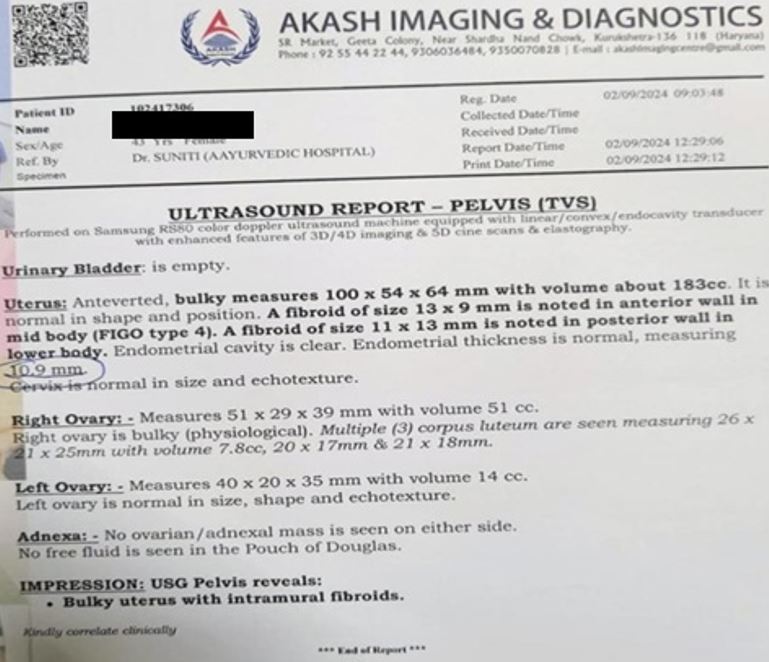Holistic Healing: Ayurvedic approaches to manage Uterine Fibroids - A Case Study
DOI:
https://doi.org/10.21760/jaims.10.5.52Keywords:
Ayurveda, Asrugdara, Granthi, uterine fibroid, Trayamanadi Kashay, MenorrhagiaAbstract
Uterine fibroids are the most frequent solid benign tumors among women of reproductive age. Symptoms of uterine fibroids adversely affect physical and social functioning, women's health-related quality of life, and productivity at work. A 43 year old female patient visited the outpatient department with menorrhagia and low back pain complaints. Ultrasound scan showed intramural fibroid in anterior wall and posterior wall of Uterus. Hysterectomy for the same was advised; but the patient refused to undergo the surgery and was looking for non-hormonal therapy. She was treated following the Ayurvedic line of treatment of Asrugdara and Granthi which is linked to Menorrhagia (presenting complaint). She was given Trayamanadi Kashay, Manjishtha Tablet, Capsule posex forte, Chandraprabha Vati, Ashokarishta, from Outpatient department. Treatment was extended for 3 months with a follow up once in 15days and a repeat scan showed shrinking size of the fibroid and relief in symptoms. A follow-up scan also showed the disappearance of the fibroids. Throughout the period of treatment patient has not complained of any adverse effects with regard to the advancement of disease nor with respect to the medications. An effort has been made to discuss the successful treatment of fibroid with non-hormonal medications in a mid-forties patient. This article aims to inspire confidence among Ayurveda practitioners about the safe, noninvasive, non-hormonal cost-effective treatment of fibroids by Ayurvedic management.
Downloads
References
Bulun SE. Uterine fibroids. N Engl J Med. 2013 Oct 3;369(14):1344–55. doi:10.1056/NEJMra1209993. PMID: 24088094.
Donnez J. Efficacy and safety of repeated use of Ulipristal acetate in uterine fibroids. Fertil Steril. 2015;103(2):0015–0282.
Stewart EA. Uterine fibroids. Lancet. 2001;357(9252):293–8.
Moravek MB, Bulun SE. Endocrinology of uterine fibroids: steroid hormones, stem cells, and genetic contribution. Curr Opin Obstet Gynecol. 2015;27(4):276–83.
Dhiman K. Ayurvedic intervention in the management of uterine fibroids: a case series. Ayu. 2014;35(3):303–8.
Mayuri Ramkrushna Gondhane, Swathi C., Ashutosh Chaturvedi. Uterine Fibroids: A comprehensive overview in Ayurveda. Int. J. Res. Ayurveda Pharm. 2023;14(6):56-58
Mayuri Ramkrushna Gondhane, Swathi C., Ashutosh Chaturvedi. Uterine Fibroids: A comprehensive overview in Ayurveda. Int. J. Res. Ayurveda Pharm. 2023;14(6):56-58
Sharma RK, Dash B. Charaka Samhita. Vol. I, Sutra Sthana. Varanasi: Chaukhamba Orientalia; 2014. p. 576.
Geetika. Management of intramural uterine fibroid by Ayurveda. Int J Ayu Pharm Res. 2024 Jun;12(6).
Gupta S. Effect of Trayamanadi Kashaya in PCOS: A Case Report. World J Pharm Res. 2023;12(12):2378–85.
Chavan TR. Pharmacological activity of Manjistha (Rubia cordifolia). Int J Innov Res Technol;11(7). ISSN: 2349-6002.
Sen GD. Pradarrogadhikar. In: Mishra S, editor. Bhaishajyaratnavali. Rev ed. Varanasi: Chaukhamba Surbharti Prakashana; 2007. p. 1038.
Posex Forte Capsule: uses, ingredients, dose. Available from: https://www.ayurmedinfo.com
Ministry of Health and Family Welfare. Ayurvedic Formulary of India. Part I – Part A. 2nd ed. New Delhi: Govt. of India; 2016. p. 512–5.
Ministry of Health and Family Welfare. Ayurvedic Formulary of India. Part I – Part A. 2nd ed. New Delhi: Govt. of India; 2016. p. 512–5.
Dash M. Probable mode of action of Hingwashtak Churna: a critical review. Int J Res Ayurveda Pharm. 2016;7(Suppl 3):1–8.















